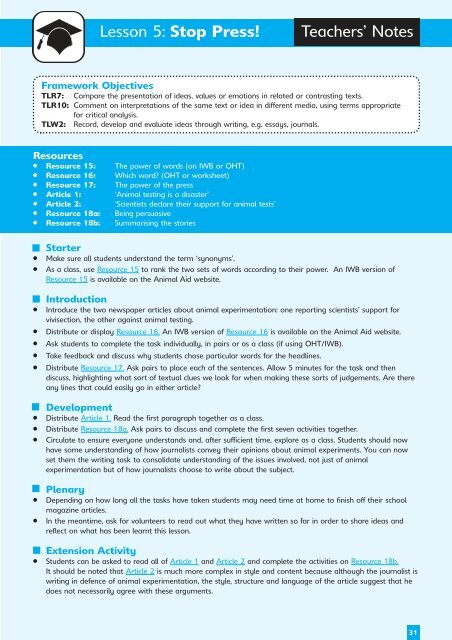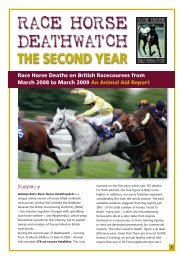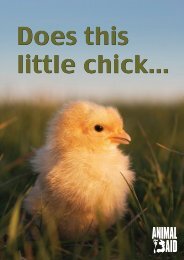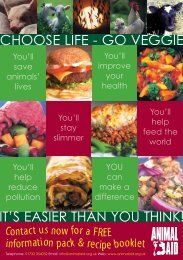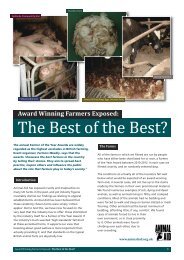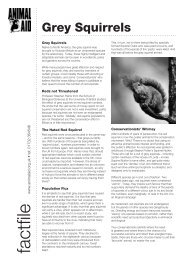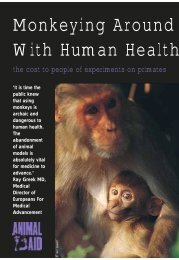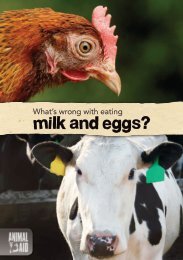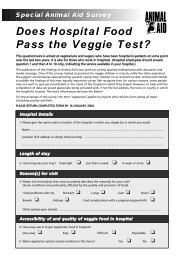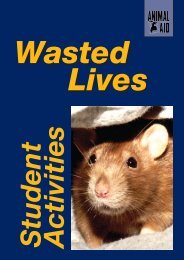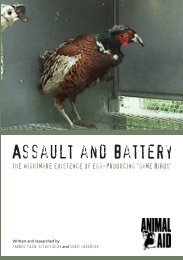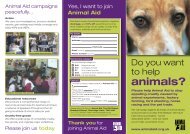English Resource Booklet 2 - Animal Aid
English Resource Booklet 2 - Animal Aid
English Resource Booklet 2 - Animal Aid
You also want an ePaper? Increase the reach of your titles
YUMPU automatically turns print PDFs into web optimized ePapers that Google loves.
Lesson 5: Stop Press!Teachers’ NotesFramework ObjectivesTLR7: Compare the presentation of ideas, values or emotions in related or contrasting texts.TLR10: Comment on interpretations of the same text or idea in different media, using terms appropriatefor critical analysis.TLW2: Record, develop and evaluate ideas through writing, e.g. essays, journals.<strong>Resource</strong>s• <strong>Resource</strong> 15: The power of words (on IWB or OHT)• <strong>Resource</strong> 16: Which word? (OHT or worksheet)• <strong>Resource</strong> 17: The power of the press• Article 1: ‘<strong>Animal</strong> testing is a disaster’• Article 2: ‘Scientists declare their support for animal tests’• <strong>Resource</strong> 18a: Being persuasive• <strong>Resource</strong> 18b: Summarising the storiesStarter• Make sure all students understand the term ‘synonyms’.• As a class, use <strong>Resource</strong> 15 to rank the two sets of words according to their power. An IWB version of<strong>Resource</strong> 15 is available on the <strong>Animal</strong> <strong>Aid</strong> website.Introduction• Introduce the two newspaper articles about animal experimentation: one reporting scientists’ support forvivisection, the other against animal testing.• Distribute or display <strong>Resource</strong> 16. An IWB version of <strong>Resource</strong> 16 is available on the <strong>Animal</strong> <strong>Aid</strong> website.• Ask students to complete the task individually, in pairs or as a class (if using OHT/IWB).• Take feedback and discuss why students chose particular words for the headlines.• Distribute <strong>Resource</strong> 17. Ask pairs to place each of the sentences. Allow 5 minutes for the task and thendiscuss, highlighting what sort of textual clues we look for when making these sorts of judgements. Are thereany lines that could easily go in either article?Development• Distribute Article 1. Read the first paragraph together as a class.• Distribute <strong>Resource</strong> 18a. Ask pairs to discuss and complete the first seven activities together.• Circulate to ensure everyone understands and, after sufficient time, explore as a class. Students should nowhave some understanding of how journalists convey their opinions about animal experiments. You can nowset them the writing task to consolidate understanding of the issues involved, not just of animalexperimentation but of how journalists choose to write about the subject.Plenary• Depending on how long all the tasks have taken students may need time at home to finish off their schoolmagazine articles.• In the meantime, ask for volunteers to read out what they have written so far in order to share ideas andreflect on what has been learnt this lesson.Extension Activity• Students can be asked to read all of Article 1 and Article 2 and complete the activities on <strong>Resource</strong> 18b.It should be noted that Article 2 is much more complex in style and content because although the journalist iswriting in defence of animal experimentation, the style, structure and language of the article suggest that hedoes not necessarily agree with these arguments.31


